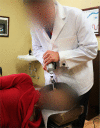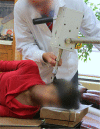Craniocervical chiropractic procedures - a précis of upper cervical chiropractic
- PMID: 26136610
- PMCID: PMC4486989
Craniocervical chiropractic procedures - a précis of upper cervical chiropractic
Abstract
Presented here is a narrative review of upper cervical procedures intended to facilitate understanding and to increase knowledge of upper cervical chiropractic care. Safety, efficacy, common misconceptions, and research are discussed, allowing practitioners, chiropractic students, and the general public to make informed decisions regarding utilization and referrals for this distinctive type of chiropractic care. Upper cervical techniques share the same theoretical paradigm in that the primary subluxation exists in the upper cervical spine. These procedures use similar assessments to determine if spinal intervention is necessary and successful once delivered. The major difference involves their use of either an articular or orthogonal radiograph analysis model when determining the presence of a misalignment. Adverse events following an upper cervical adjustment consist of mild symptomatic reactions of short-duration (< 24-hours). Due to a lack of quality and indexed references, information contained herein is limited by the significance of literature cited, which included non-indexed and/or non-peer reviewed sources.
Examen narratif de procédures de la cervicale supérieure afin de faciliter la compréhension et d’améliorer la connaissance des soins chiropratiques des cervicales supérieures. L’innocuité, l’efficacité, les méconnaissances courantes et la recherche font l’objet de discussion, ce qui permet aux praticiens, aux étudiants en chiropratique, et au public de prendre des décisions éclairées concernant l’utilisation et les recommandations pour ce type particulier de soins chiropratiques.Les techniques de la cervicale supérieure ont le même paradigme théorique, car les subluxations primaires existent dans la colonne cervicale supérieure. Ces procédures ont recours à des évaluations semblables pour déterminer si une intervention vertébrale est nécessaire et si elle est réussie une fois effectuée. La différence principale concerne l’utilisation soit d’une analyse radiographique articulaire ou orthogonale au moment de déterminer la présence d’un désalignement. Des évènements indésirables à la suite d’un ajustement de la cervicale supérieure consistent en des réactions symptomatiques légères de courte durée (< 24 heures).Étant donné le manque de références indexées et de qualité, les renseignements contenus aux présentes sont limités par l’importance des documents cités, qui comprennent des sources non indexées ou non révisées par des pairs.
Keywords: adverse events; atlas; cervical; chiropractic; chiropractic adjustment; craniocervical.
Figures












References
-
- Hynes RJR, Callender AK. Technique in the classroom at Palmer College of Chiropractic: A History in the Art of Chiropractic. J Chiropr Humanit. 2008;(15):55–66.
-
- Christensen MG. Job Analysis of Chiropractic A Project Report, Survey Analysis and Summary of the Practice of Chiropractic within the United States. Greeley, Colorado: National Board of Chiropractic Examiners; 2000.
-
- Palmer BJ. The subluxation specific – the adjustment specific. Davenport: Palmer School of Chiropractic; 1934.
-
- Wernsing AA. The atlas specific. Hollywood: Oxford Press; 1941.
LinkOut - more resources
Full Text Sources
